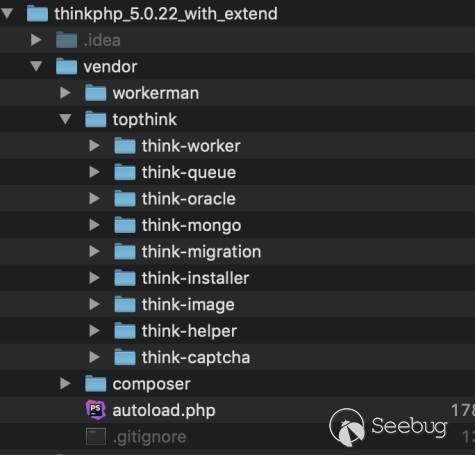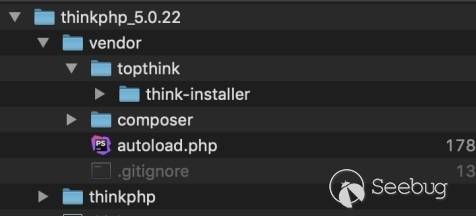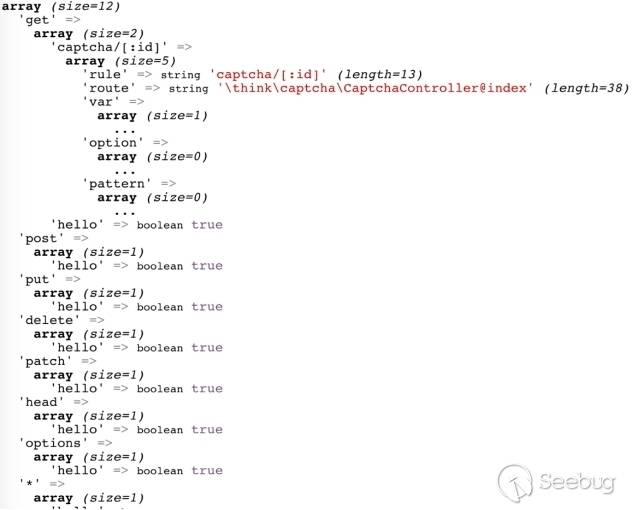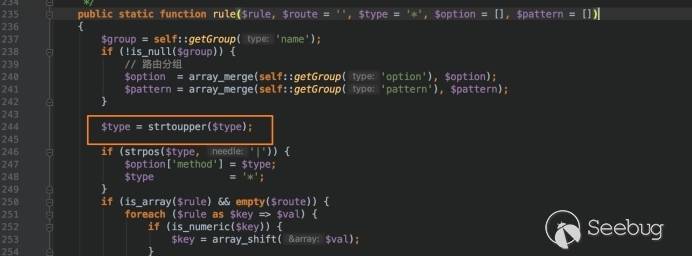

ThinkPHP5 核心类 Request 远程代码漏洞分析
source link: https://paper.seebug.org/787/
Go to the source link to view the article. You can view the picture content, updated content and better typesetting reading experience. If the link is broken, please click the button below to view the snapshot at that time.
作者:启明星辰ADLab
公众号:https://mp.weixin.qq.com/s/DGWuSdB2DvJszom0C_dkoQ
漏洞介绍
2019年1月11日,ThinkPHP团队发布了一个补丁更新,修复了一处由于不安全的动态函数调用导致的远程代码执行漏洞。该漏洞危害程度非常高,默认条件下即可执行远程代码。启明星辰ADLab安全研究员对ThinkPHP的多个版本进行源码分析和验证后,确认具体受影响的版本为ThinkPHP5.0-5.0.23完整版。
漏洞复现
本地环境采用ThinkPHP 5.0.22完整版+PHP5.5.38+Apache进行复现。安装环境后执行POC即可执行系统命令,如图:

漏洞分析
以官网下载的5.0.22完整版进行分析,首先定位到漏洞关键点:
thinkphp/library/think/Request.php:518
public function method($method = false)
{
if (true === $method) {
// 获取原始请求类型
return $this->server('REQUEST_METHOD') ?: 'GET';
} elseif (!$this->method) {
if (isset($_POST[Config::get('var_method')])) {
$this->method = strtoupper($_POST[Config::get('var_method')]);
$this->{$this->method}($_POST);
} elseif (isset($_SERVER['HTTP_X_HTTP_METHOD_OVERRIDE'])) {
$this->method = strtoupper($_SERVER['HTTP_X_HTTP_METHOD_OVERRIDE']);
} else {
$this->method = $this->server('REQUEST_METHOD') ?: 'GET';
}
}
return $this->method;
}在method函数的第二个if分支中,引入了一个外部可控的数据$_POST[Config::get[‘var_method’]。而var_method的值为_method。

取得$_POST[‘_method’]的值并将其赋值给$this->method,然后动态调用$this->{$this->method}($_POST)。这意味着攻击者可以调用该类任意函数并以$_POST作为第一个参数。如果动态调用__construct函数,则会导致代码执行。
Request类的__construct函数如下:
protected function __construct($options = [])
{
foreach ($options as $name => $item) {
if (property_exists($this, $name)) {
$this->$name = $item;
}
}
if (is_null($this->filter)) {
$this->filter = Config::get('default_filter');
}
// 保存 php://input
$this->input = file_get_contents('php://input');
}由于$options参数可控,攻击者可以覆盖该类的filter属性、method属性以及get属性的值。而在Request类的param函数中:
public function param($name = '', $default = null, $filter = '')
{
if (empty($this->mergeParam)) {
$method = $this->method(true);
// 自动获取请求变量
switch ($method) {
case 'POST':
$vars = $this->post(false);
break;
case 'PUT':
case 'DELETE':
case 'PATCH':
$vars = $this->put(false);
break;
default:
$vars = [];
}
// 当前请求参数和URL地址中的参数合并
$this->param = array_merge($this->param, $this->get(false), $vars, $this->route(false));
$this->mergeParam = true;
}
if (true === $name) {
// 获取包含文件上传信息的数组
$file = $this->file();
$data = is_array($file) ? array_merge($this->param, $file) : $this->param;
return $this->input($data, '', $default, $filter);
}
return $this->input($this->param, $name, $default, $filter);
}当$this->mergeParam为空时,这里会调用$this->get(false)。跟踪$this->get函数:
public function get($name = '', $default = null, $filter = null)
{
if (empty($this->get)) {
$this->get = $_GET;
}
if (is_array($name)) {
$this->param = [];
return $this->get = array_merge($this->get, $name);
}
return $this->input($this->get, $name, $default, $filter);
}该函数末尾调用了$this->input函数,并将$this->get传入,而$this->get的值是攻击者可控的。跟踪$this->input函数:
public function input($data = [], $name = '', $default = null, $filter = '')
{
if (false === $name) {
// 获取原始数据
return $data;
}
$name = (string) $name;
if ('' != $name) {
// 解析name
if (strpos($name, '/')) {
list($name, $type) = explode('/', $name);
} else {
$type = 's';
}
// 按.拆分成多维数组进行判断
foreach (explode('.', $name) as $val) {
if (isset($data[$val])) {
$data = $data[$val];
} else {
// 无输入数据,返回默认值
return $default;
}
}
if (is_object($data)) {
return $data;
}
}
// 解析过滤器
$filter = $this->getFilter($filter, $default);
if (is_array($data)) {
array_walk_recursive($data, [$this, 'filterValue'], $filter);
reset($data);
} else {
$this->filterValue($data, $name, $filter);
}
if (isset($type) && $data !== $default) {
// 强制类型转换
$this->typeCast($data, $type);
}
return $data;
}该函数调用了$this->getFileter取得过滤器。函数体如下:
protected function getFilter($filter, $default)
{
if (is_null($filter)) {
$filter = [];
} else {
$filter = $filter ?: $this->filter;
if (is_string($filter) && false === strpos($filter, '/')) {
$filter = explode(',', $filter);
} else {
$filter = (array) $filter;
}
}
$filter[] = $default;
return $filter;
}$this->filter的值是攻击者通过调用构造函数覆盖控制的,将该值返回后将进入到input函数:
if (is_array($data)) {
array_walk_recursive($data, [$this, 'filterValue'], $filter);
reset($data);
}查看filterValue函数如下:
private function filterValue(&$value, $key, $filters)
{
$default = array_pop($filters);
foreach ($filters as $filter) {
if (is_callable($filter)) {
// 调用函数或者方法过滤
$value = call_user_func($filter, $value);
} elseif (is_scalar($value)) {
if (false !== strpos($filter, '/')) {
// 正则过滤
if (!preg_match($filter, $value)) {
// 匹配不成功返回默认值
$value = $default;
break;
}
} elseif (!empty($filter)) {
// filter函数不存在时, 则使用filter_var进行过滤
// filter为非整形值时, 调用filter_id取得过滤id
$value = filter_var($value, is_int($filter) ? $filter : filter_id($filter));
if (false === $value) {
$value = $default;
break;
}
}
}
}
return $this->filterExp($value);
}在call_user_func函数的调用中,$filter可控,$value可控。因此,可致代码执行。
漏洞触发流程:
从ThinkPHP5的入口点开始分析:
thinkphp/library/think/App.php:77
public static function run(Request $request = null)
{
$request = is_null($request) ? Request::instance() : $request;
try {
$config = self::initCommon();
// 模块/控制器绑定
if (defined('BIND_MODULE')) {
BIND_MODULE && Route::bind(BIND_MODULE);
} elseif ($config['auto_bind_module']) {
// 入口自动绑定
$name = pathinfo($request->baseFile(), PATHINFO_FILENAME);
if ($name && 'index' != $name && is_dir(APP_PATH . $name)) {
Route::bind($name);
}
}
$request->filter($config['default_filter']);
// 默认语言
Lang::range($config['default_lang']);
// 开启多语言机制 检测当前语言
$config['lang_switch_on'] && Lang::detect();
$request->langset(Lang::range());
// 加载系统语言包
Lang::load([
THINK_PATH . 'lang' . DS . $request->langset() . EXT,
APP_PATH . 'lang' . DS . $request->langset() . EXT,
]);
// 监听 app_dispatch
Hook::listen('app_dispatch', self::$dispatch);
// 获取应用调度信息
$dispatch = self::$dispatch;
// 未设置调度信息则进行 URL 路由检测
if (empty($dispatch)) {
$dispatch = self::routeCheck($request, $config);
}
// 记录当前调度信息
$request->dispatch($dispatch);
// 记录路由和请求信息
if (self::$debug) {
Log::record('[ ROUTE ] ' . var_export($dispatch, true), 'info');
Log::record('[ HEADER ] ' . var_export($request->header(), true), 'info');
Log::record('[ PARAM ] ' . var_export($request->param(), true), 'info');
}
// 监听 app_begin
Hook::listen('app_begin', $dispatch);
// 请求缓存检查
$request->cache(
$config['request_cache'],
$config['request_cache_expire'],
$config['request_cache_except']
);
$data = self::exec($dispatch, $config);run函数第一行便实例化了一个Request类,并赋值给了$request。然后调用routeCheck($request,$config):
public static function routeCheck($request, array $config)
{
$path = $request->path();
$depr = $config['pathinfo_depr'];
$result = false;
// 路由检测
$check = !is_null(self::$routeCheck) ? self::$routeCheck : $config['url_route_on'];
if ($check) {
// 开启路由
if (is_file(RUNTIME_PATH . 'route.php')) {
// 读取路由缓存
$rules = include RUNTIME_PATH . 'route.php';
is_array($rules) && Route::rules($rules);
} else {
$files = $config['route_config_file'];
foreach ($files as $file) {
if (is_file(CONF_PATH . $file . CONF_EXT)) {
// 导入路由配置
$rules = include CONF_PATH . $file . CONF_EXT;
is_array($rules) && Route::import($rules);
}
}
}
// 路由检测(根据路由定义返回不同的URL调度)
$result = Route::check($request, $path, $depr, $config['url_domain_deploy']);
$must = !is_null(self::$routeMust) ? self::$routeMust : $config['url_route_must'];
if ($must && false === $result) {
// 路由无效
throw new RouteNotFoundException();
}
}
// 路由无效 解析模块/控制器/操作/参数... 支持控制器自动搜索
if (false === $result) {
$result = Route::parseUrl($path, $depr, $config['controller_auto_search']);
}
return $result;
}这里调用Route::check进行路由检测。函数如下:
public static function check($request, $url, $depr = '/', $checkDomain = false)
{
//检查解析缓存
if (!App::$debug && Config::get('route_check_cache')) {
$key = self::getCheckCacheKey($request);
if (Cache::has($key)) {
list($rule, $route, $pathinfo, $option, $matches) = Cache::get($key);
return self::parseRule($rule, $route, $pathinfo, $option, $matches, true);
}
}
// 分隔符替换 确保路由定义使用统一的分隔符
$url = str_replace($depr, '|', $url);
if (isset(self::$rules['alias'][$url]) || isset(self::$rules['alias'][strstr($url, '|', true)])) {
// 检测路由别名
$result = self::checkRouteAlias($request, $url, $depr);
if (false !== $result) {
return $result;
}
}
$method = strtolower($request->method());
// 获取当前请求类型的路由规则
$rules = isset(self::$rules[$method]) ? self::$rules[$method] : [];
// 检测域名部署
if ($checkDomain) {
self::checkDomain($request, $rules, $method);
}
// 检测URL绑定
$return = self::checkUrlBind($url, $rules, $depr);
if (false !== $return) {
return $return;
}
if ('|' != $url) {
$url = rtrim($url, '|');
}
$item = str_replace('|', '/', $url);
if (isset($rules[$item])) {
// 静态路由规则检测
$rule = $rules[$item];
if (true === $rule) {
$rule = self::getRouteExpress($item);
}
if (!empty($rule['route']) && self::checkOption($rule['option'], $request)) {
self::setOption($rule['option']);
return self::parseRule($item, $rule['route'], $url, $rule['option']);
}
}
// 路由规则检测
if (!empty($rules)) {
return self::checkRoute($request, $rules, $url, $depr);
}
return false;
}注意红色字体部分。对应开头的第一个步骤,也就是调用method函数进行变量覆盖。这里需要覆盖的属性有$this->filter,$this->method,$this->get。因为$request->method()的返回值为$this->method,所以该值也需要被控制。这里返回值赋值给了$method,然后取出self::$rules[$method]的值给$rules。这里需要注意:THINKPHP5有自动类加载机制,会自动加载vendor目录下的一些文件。但是完整版跟核心版的vendor目录结构是不一样的。
完整版的目录结构如下:

而核心版的目录结构如下:

可以看到完整版比核心版多出了几个文件夹。特别需要注意的就是think-captcha/src这个文件夹里有一个helper.php文件:

这里调用\think\Route::get函数进行路由注册的操作。而这步操作的影响就是改变了上文提到的self::$rules的值。有了这个路由,才能进行RCE,否则不成功。这也就是为什么只影响完整版,而不影响核心版的原因。此时的self::$rules的值为:

那么,当攻击者控制返回的$method的值为get的时候,$rules的值就是这条路由的规则。然后回到上文取到$rules之后,根据传入的URL取得$item的值,使得$rules[$item]的值为captcha路由数组,就可以进一步调用到self::parseRule函数。函数体略长,这里取关键点:
private static function parseRule($rule, $route, $pathinfo, $option = [], $matches = [], $merge = false)
{
// 解析路由规则
......
......
if ($route instanceof \Closure) {
// 执行闭包
$result = ['type' => 'function', 'function' => $route];
} elseif (0 === strpos($route, '/') || 0 === strpos($route, 'http')) {
// 路由到重定向地址
$result = ['type' => 'redirect', 'url' => $route, 'status' => isset($option['status']) ? $option['status'] : 301];
} elseif (0 === strpos($route, '\\')) {
// 路由到方法
$method = strpos($route, '@') ? explode('@', $route) : $route;
$result = ['type' => 'method', 'method' => $method];
} elseif (0 === strpos($route, '@')) {
// 路由到控制器
$result = ['type' => 'controller', 'controller' => substr($route, 1)];
} else {
// 路由到模块/控制器/操作
$result = self::parseModule($route);
}
return $result;
}此时传递进来的$route的值为\think\captcha\CaptchaController@index。因此进入的是标注红色的if分支中。在这个分支中,$result的’type’键对应的值为‘method’。然后将$result层层返回到run函数中,并赋值给了$dispatch。
// 未设置调度信息则进行 URL 路由检测
if (empty($dispatch)) {
$dispatch = self::routeCheck($request, $config);
}
// 记录当前调度信息
$request->dispatch($dispatch);
// 记录路由和请求信息
if (self::$debug) {
Log::record('[ ROUTE ] ' . var_export($dispatch, true), 'info');
Log::record('[ HEADER ] ' . var_export($request->header(), true), 'info');
Log::record('[ PARAM ] ' . var_export($request->param(), true), 'info');
}
// 监听 app_begin
Hook::listen('app_begin', $dispatch);
// 请求缓存检查
$request->cache(
$config['request_cache'],
$config['request_cache_expire'],
$config['request_cache_except']
);
$data = self::exec($dispatch, $config);然后将$dispatch带入到self::exec函数中:
protected static function exec($dispatch, $config)
{
switch ($dispatch['type']) {
case 'redirect': // 重定向跳转
$data = Response::create($dispatch['url'], 'redirect')
->code($dispatch['status']);
break;
case 'module': // 模块/控制器/操作
$data = self::module(
$dispatch['module'],
$config,
isset($dispatch['convert']) ? $dispatch['convert'] : null
);
break;
case 'controller': // 执行控制器操作
$vars = array_merge(Request::instance()->param(), $dispatch['var']);
$data = Loader::action(
$dispatch['controller'],
$vars,
$config['url_controller_layer'],
$config['controller_suffix']
);
break;
case 'method': // 回调方法
$vars = array_merge(Request::instance()->param(), $dispatch['var']);
$data = self::invokeMethod($dispatch['method'], $vars);
break;
case 'function': // 闭包
$data = self::invokeFunction($dispatch['function']);
break;
case 'response': // Response 实例
$data = $dispatch['response'];
break;
default:
throw new \InvalidArgumentException('dispatch type not support');
}
return $data;
}进入到红色标注的分支,该分支调用Request类的param方法。因此,满足了利用链的第三步,造成命令执行。
启明星辰ADLab安全研究员对ThinkPHP5.0-5.0.23每个版本都进行了分析,发现ThinkPHP5.0.2-5.0.23可以使用同一个POC,而ThinkPHP5.0-5.0.1需要更改一下POC,原因在于Route.php的rule函数的一个实现小差异。
ThinkPHP5.0-5.0.1版本的thinkphp/library/think/Route.php:235,将$type转换成了大写:

在ThinkPHP5.0.2-5.0.23版本中,rule函数中却将$type转换成了小写:

补丁分析
在ThinkPHP5.0.24中,增加了对$this->method的判断,不允许再自由调用类函数。

结论
强烈建议用户升级到ThinkPHP5.0.24版本,并且不要开启debug模式,以免遭受攻击。
启明星辰积极防御实验室(ADLab)
ADLab成立于1999年,是中国安全行业最早成立的攻防技术研究实验室之一,微软MAPP计划核心成员。截止目前,ADLab通过CVE发布Windows、Linux、Unix等操作系统安全或软件漏洞近400个,持续保持国际网络安全领域一流水准。实验室研究方向涵盖操作系统与应用系统安全研究、移动智能终端安全研究、物联网智能设备安全研究、Web安全研究、工控系统安全研究、云安全研究。研究成果应用于产品核心技术研究、国家重点科技项目攻关、专业安全服务等。

 本文由 Seebug Paper 发布,如需转载请注明来源。本文地址:https://paper.seebug.org/787/
本文由 Seebug Paper 发布,如需转载请注明来源。本文地址:https://paper.seebug.org/787/
Recommend
About Joyk
Aggregate valuable and interesting links.
Joyk means Joy of geeK